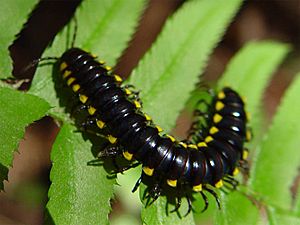Yellow-spotted millipede facts for kids
Quick facts for kids Yellow-spotted millipede |
|
|---|---|
 |
|
| Scientific classification | |
| Kingdom: | |
| Phylum: | |
| Class: | |
| Order: |
Polydesmida
|
| Family: |
Xystodesmidae
|
| Genus: | |
| Species: |
H. haydeniana
|
| Binomial name | |
| Harpaphe haydeniana (Wood, 1864)
|
|
| Subspecies | |
|
|
| Synonyms | |
|
Subspecies synonymy
H. h. cummingsiensis
• Pachydesmus cummingsiensis Verhoeff, 1944 H. h. haydeniana • Polydesmus haydenianus Wood, 1864 • Polydesmus intaminatus Karsch, 1881 • Fontaria simoni Brolemann, • Harpaphe haydeniana Cook, 1904 • Harpapahe intaminata Cook, 1904 • Isaphe simplex Chamberlin, 1918 H. h. inlignea • Harpaphe inlignea Chamberlin, 1949 H. h. scotia • Paimokia scotia Chamberlin, 1941 • Harpaphe clara Chamberlin, 1949 |
|
Harpaphe haydeniana, often called the yellow-spotted millipede, almond-scented millipede, or cyanide millipede, is a fascinating creature. This species of millipede lives in the damp forests along the Pacific coast of North America. You can find it from Southeast Alaska all the way down to California. Its dark body with bright yellow spots is a warning sign. It tells predators that it can release a toxic defense. This defense is a chemical called hydrogen cyanide. Even though it has these special names, many other flat-backed millipedes around the world also have similar colors, cyanide defense, and an almond smell.
Contents
About the Yellow-Spotted Millipede
When fully grown, H. haydeniana can reach a length of about 4 to 5 centimeters (1.6 to 2 inches). Their bodies are usually black or olive green on top. They have bright yellow patches along their sides. These yellow spots are very easy to see.
A yellow-spotted millipede has about twenty body segments. Males have 30 pairs of legs, while females have 31 pairs. This small difference is because one pair of legs on the seventh segment of males is special. These legs are called gonopods and are used for reproduction. These millipedes can live for about 2 to 3 years.
Where Does It Live?
The yellow-spotted millipede lives in a wide area. It can be found from southeast Alaska south to Monterey County, California. It also lives as far east as the Sierra Nevada mountains. These millipedes prefer moist forest environments.
Its Role in Nature
H. haydeniana plays an important part in the forest ecosystem. It helps break down leaf litter (fallen leaves and twigs). By doing this, it releases nutrients back into the soil. This helps other plants and organisms grow. You can often find many of these millipedes in redwood forests. Young millipedes eat humus, which is decayed plant and animal matter in the soil.
This millipede has very few predators. This is because of its bright warning colors and its ability to release hydrogen cyanide when it feels threatened. This defense is why it's called the "cyanide millipede" or "almond-scented millipede." Cyanide smells like almonds. While this defense is amazing, H. haydeniana is not the only millipede that can do this. However, one specific ground beetle, Promecognathus laevissimus, is a special predator that can eat this millipede.
Millipede Look-Alikes
There are two other species of Harpaphe that look very similar to H. haydeniana. These are H. pottera and H. telodonta. They also have yellow-tipped keels (the flat parts on their sides). H. telodonta, found in Humboldt and Del Norte counties, California, is a bit more brown. Its keels are also more pointed. H. pottera, found in Mendocino and Humboldt counties, is very hard to tell apart. Scientists usually need to look closely at the male reproductive organs (gonopods) to know the difference.
The Harpaphe genus belongs to the family Xystodesmidae. This family includes many other millipedes with similar markings. Some of these are Boraria, Chonaphe, Paimokia, Hybaphe, and Montaphe. To be sure which species it is, scientists often need to examine the male gonopods. However, the sharp, pointed corners of the side plates (paranota) can help tell Harpaphe apart from Hybaphe and Chonaphe.
Outside of North America, some millipedes look like H. haydeniana but are not related. For example, Anoplodesmus saussurii has sometimes been mistaken for it. Another one is Asiomorpha coarctata, which is from Southeast Asia but has spread to other parts of the world, like the American Gulf Coast. Many other millipedes in the order Polydesmida (the largest group of millipedes) can also release hydrogen cyanide as a defense.
See also
 In Spanish: Harpaphe haydeniana para niños
In Spanish: Harpaphe haydeniana para niños



